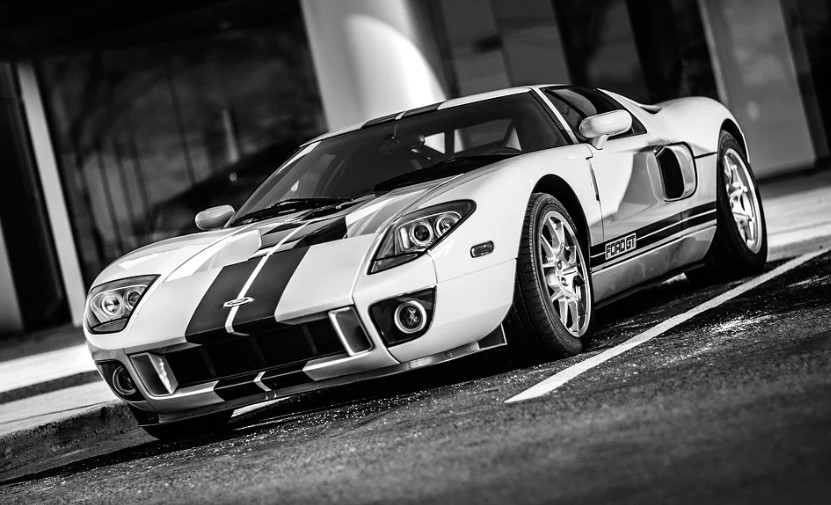Last Updated on February 18, 2023 by Leepu Da Maxim

The Ford Mustang is not a muscle car. Why? The Mustang is more of a pony than a muscle car. Pony cars can have small-block V8s, big-block V8s, six-cylinder engines, or even four-cylinder engines. So, for the sake of simplicity, all Mustangs are pony cars.
What is a Muscle Car?
A muscle car, loosely defined, is an American automobile with rear-wheel drive and a strong (V8) engine. According to most car historians, the first muscle car was the 1949 Oldsmobile Rocket. With a V8 engine installed, this automobile was quick. Along with the Shelby upgrades, that put the Mustang on the performance map.
By this description, the Mustangs of the late 1960s were muscle cars. However, as the Mustang changed through time, it lost its muscle and never returned to that discourse.
Why Does the Ford Mustang Not Fit the Muscle Car Class?

An automobile’s classification as a sports car, muscle car, or pony car gets determined by various factors. You can decide if Ford Mustang belongs to which class by looking at engine specifications, weight, car design, and driving system.
Engines
The engine specs are crucial in establishing whether it is a muscle or a pony car. Almost all muscle vehicles have the exact engine specifications. These include a large V8 engine with a lot of weight.
Significant technical variances exist between the engine specs of a typical sports vehicle. Sports vehicles often have less powerful engines than muscle cars, allowing them to be lighter.
Sports vehicles have superior handling due to their lighter weight. In general, sports automobiles get distinguished by an inline 6-cylinder engine.
Engine Specifications of Various Mustang Generations
| Generation | Year | Specs |
| 1st | 1964-1973 | 2.8L V6, 3.3 L V6, 4.1L V6, 4.3L V8, 4.7L V8, 4.9L V8, 5.7 L V8, 5.7 L V8, 6.4L V8, 7.0L V8 |
| 2nd | 1974-1978 | 4.9L V8 |
| 3rd | 1979-1983 | 4.6L I6, 2.3L I6, 2.8L V6, |
| 4th | 1994-2004 | 3.8L V6, 3.8L V6, 4.6L V8 |
| 5th | 2005-2014 | 2.0L V8, 2.3L I4, 3.7L V6, 4.0L V6, 5.0L V6, 5.00L V8, 5.4L V8, 5.8L V8 |
| 6th | 2015 | 2.3L I4, 5.0L V8, 5.0L V8 |
The table above shows that the first generation produced several versions with I4, I6, and small-block V8 engines. As a result, they were first classified as sports or pony cars.
The following models of the first generation, on the other hand, did not match the criteria of sports or muscle cars. They had V8 engines with a 7.8L displacement and a lot of power. They were large automobiles with exceptional acceleration and handling.
On the other hand, Ford markets the newest generation of Ford Mustangs as sports vehicles. That is due to a greater emphasis on handling and the addition of technology like electronic line-lock and independent rear suspension.
The 6th generation with the 2.3 Ecoboost engine is best classified as a sports vehicle, while the 5.0 V8 engines are pony cars.
Design
The design also influences the automobile, whether a sports car, a pony car, or a muscle car. Two doors are standard in classic muscle automobiles. Almost all muscle vehicles featured a V8 engine behind a two-door coupe in the past.
These automobiles’ design was characterized by a large trunk, a broad stance, and sweeping fenders. These designs, however, have evolved slightly throughout time. Modern muscle cars feature large front grills to allow for optimal circulation and cooling of the engine.
The Ford Mustang’s design has evolved significantly over time. The 1964 Ford Mustang appears to be a muscle vehicle, but engine specs indicate otherwise. Although the massive front grills give it the appearance of a muscle vehicle, this is a stretch. People usually classify it as a sports automobile, but it’s a pony car.
Weight
the car weight is not a strict categorization. Automobile experts employ several weight ranges for various sorts of vehicles. However, we shall use this categorization to establish the Ford Mustang’s class.
Sports vehicles, as expected, are the lightest of the bunch. That is because a lower weight aids them in turning tight curves and improves handling.
Muscle and pony cars are often more oversized vehicles built to accelerate quickly in a straight line. Regarding the weight of the Ford Mustang, the original 1964 Ford Mustang weighed roughly 2100 pounds.
That demonstrates that they were sporting vehicles. Later variants, such as the Ford Mustang GT and Ford Mustang GT Shelby, weighed 3800 pounds, earning them the nickname “pony cars.”
System of Propulsion
The drive system is also a significant consideration when debating whether the Ford Mustang is a muscle or sports car. The rule of thumb is that muscle cars will always be rear-wheel drive. However, you can say the same for pony automobiles.
The answer is different when it comes to sports automobiles. Although many sports vehicles of this era have rear-wheel drive, many additionally feature all-wheel drive for increased traction.
AWD’s (All Wheel Drive) 50-50 weight distribution improves handling substantially, making it an excellent choice for sports car designers.
Looking at the Ford Mustang, we can see an RWD (Rear Wheel Drive) version for each generation. It becomes a sports vehicle when this RWD gets combined with a I6 or I4 engine. Later iterations included a small-block V8, making them more appropriately classified as pony cars.
Frequently Asked Questions
Is a Mustang Considered a Pony Car or a Muscle Car?
Modern Mustangs and Camaros are still pony cars, but the emphasis on suspension, handling, and Lap record lap times has muddied our terminology. The super-fast Mustang GT350 and Camaro ZL1 are the sports cars on the track.
A muscle car’s main characteristic is its vast displacement engine (often more than 5 liters.) As a result, “muscle” alludes to the extensive engine and high torque offered. Muscle vehicles aren’t very tiny and don’t have excellent handling.
Is the Mustang a Good Automobile?
Is the Ford Mustang an Excellent Automobile? Yes, the Ford Mustang is a fantastic vehicle. It has various powerful engines and the corner-carving performance that makes sports cars alluring. The Mustang boasts a smooth ride, comfy front seats, and a stylish interior and exterior.
It’s a non-luxury automobile with a high price tag since its battery is electric and packed with technology.
One can divide Mustangs into two categories: pony cars and sports cars. However, all Ford Mustangs are legendary (except for the Mach-E).
In Conclusion, most people in the automotive industry mistakenly classify Mustangs as muscle cars. This is attributed to the vehicle’s acceleration power and its general performance. The Mustang might exhibit all traits of a muscle car, but it is lightweight; thus, it is in the category of sports cars; more precisely, it is a pony car.
The Final Thought
The Ford Mustang is a controversial car viewed by many automotive enthusiasts as a muscle car. However, all indicators point out that the Mustang is instead a pony car but not a muscle car.
Reference 1: Is a Mustang a Muscle Or Sports Car? – Magazine247.net
Reference 2:Ford Mustang Is Not a Muscle Car It’s a … (Fill in the Blank) | Torque News

Hi, I’m Leepu Da Maxim , a dedicated car enthusiast with over 10 years of experience in this field, and I’m thrilled to share my passion and expertise with fellow car enthusiasts like you. My journey began in my hometown West Jordan, Utah, where my fascination with the mechanics and design of cars sparked at a young age. Over the years, this passion has evolved into a commitment to providing accurate, insightful, and engaging information about all things automotive through CarsAmazing .

